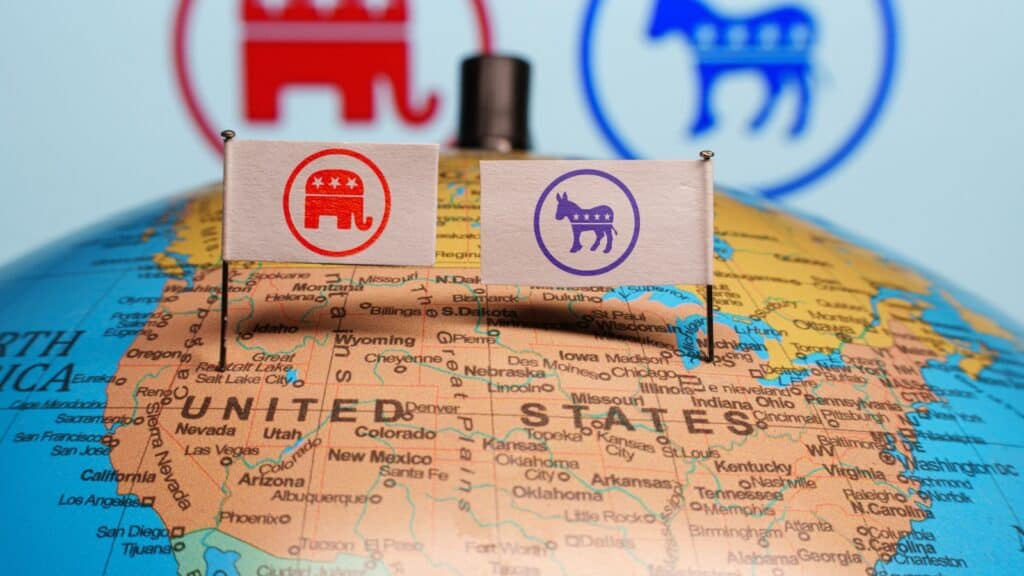Trump’s Border Wall: A $15 Billion Gamble – Was It Worth It?
The construction of the U.S.-Mexico border wall was a hallmark of Donald Trump’s presidency, promising to bolster national security and curb illegal immigration. As the project unfolded, it became a focal point of political and public debate, raising questions about its financial implications, effectiveness, and broader impact. This analysis looks at the current status of the wall, the financial resources allocated, and the successes and failures that have emerged from this ambitious initiative.
Construction Progress

Donald Trump’s administration built approximately 452 miles of new or replacement border wall along the U.S.-Mexico border by January 2021. However, only about 47 miles of this was new wall where no barriers previously existed. The vast majority was replacement of older existing barriers.
Costs and Funding

The Trump administration spent approximately $15 billion on border wall construction. This funding came from various sources:
– About $5 billion was appropriated by Congress for border security
– Around $10 billion was diverted from military construction and counternarcotics programs, bypassing Congressional approval
The projected cost was about $20.4 million per mile of wall constructed.
Frequent Failures

1. Failed to deliver on campaign promise: Trump promised to build 1,000 miles of new wall, but only managed to construct 47 miles of new barrier where none existed before.
2. Environmental damage: The wall construction caused significant harm to ecosystems, endangered species, and water resources along the border.
3. Cultural site destruction: Several Native American cultural and burial sites were damaged during construction.
4. Legal issues: The administration had to waive dozens of laws protecting the environment, historical sites, and Native American lands to expedite construction.
5. Ineffective deterrent: There is little evidence that the wall significantly reduced illegal border crossings, especially since many migrants seek to be apprehended to claim asylum.
Questionable Successes

1. Rapid construction: The administration managed to build at a pace of more than a mile per day in some areas.
2. Symbolic achievement: For Trump supporters, the wall represented a tangible effort to address border security concerns.
Current Status

After taking office, President Biden halted wall construction and canceled several contracts. However, some construction has continued:
– In 2022, the Biden administration announced it would fill four gaps in the wall near Yuma, Arizona.
– As of 2024, Texas is continuing its own state-funded border wall construction under Governor Greg Abbott’s direction, with 34 miles built so far and plans for 100 miles by 2026.
In conclusion, while the Trump administration did construct hundreds of miles of border barriers, the project fell far short of its initial goals, came at a significant financial and environmental cost, and has had questionable effectiveness in deterring illegal border crossings.
Fluctuating Public Support & Opposition

The debate over the U.S.-Mexico border wall has been a contentious issue in American politics, sparking intense public opinion shifts over the years. This graph illustrates the fluctuating levels of support and opposition to the border wall from 2015 to 2024. As political landscapes and immigration policies evolved, so did public sentiment, reflecting broader societal and political dynamics.
The graph shows significant fluctuations in both support and opposition to the border wall between 2015 and 2024. Support peaked in 2020 at around 86%, while opposition peaked in 2022 at about 75%.
Overall decline in support:

Despite fluctuations, there has been a general downward trend in support for the wall. Support declined from about 51% in 2015 to around 29% by 2024.
Increasing opposition:

Opposition to the wall has generally increased over time, rising from about 37% in 2015 to around 61% by 2024.
Partisan divide:

The data shows a stark partisan divide on the issue. For example, in 2020, 86% of Republicans supported building the wall, compared to only 16% of Democrats.
Shift in public sentiment:

Early polls in 2015-2016 showed the public more evenly split or slightly in favor of the wall. By 2019-2020, multiple polls were showing majority opposition.
Impact of political events:

Major fluctuations in opinion seem to coincide with key political events, such as the 2016 election, the 2019 government shutdown over wall funding, and the 2020 election.
Recent stabilization:

The graph suggests opinion has somewhat stabilized in recent years, with opposition maintaining a significant lead over support from 2022 to 2024.
In summary, while public opinion on the border wall has fluctuated significantly over the past decade, the overall trend shows decreasing support and increasing opposition, with a persistent and widening partisan gap on the issue.
Alternatives to the Border Wall

Several alternatives to the border wall have been proposed to enhance border security while addressing humanitarian and logistical challenges:
Enhanced Technology and Surveillance

– Use of cameras, fixed towers, aerial and underground sensors, and drones to monitor the border more effectively.
– Upgrading existing surveillance equipment to improve detection and response capabilities.
Improved Asylum Processing

– Increasing the number of judges to process asylum applications more efficiently.
– Streamlining the asylum process to reduce backlogs and improve conditions for asylum seekers.
Legal Immigration Pathways

– Expanding opportunities for legal immigration to reduce the pressure on border crossings.
– Addressing root causes of migration to decrease irregular crossings.
Renovation of Ports of Entry

– Upgrading and properly staffing land ports of entry to facilitate legal crossings and intercept illegal activities.
Increased Personnel and Resources

– Investing in training and resources for Border Patrol and other agencies to enhance their effectiveness without increasing personnel numbers.
Biometric Entry-Exit System

– Implementing biometric systems at all ports of entry to efficiently screen entrants and exits.
Community and International Cooperation

– Engaging with local communities and international partners to address migration challenges collaboratively.
These alternatives aim to provide a more comprehensive and humane approach to border security, focusing on technology, legal processes, and international cooperation rather than solely physical barriers.
The Wall As A Deterrent: Success or No?

The impact of the border wall on illegal immigration rates has been mixed and complex:
1. Limited Deterrence: Research indicates that the border wall has had only a modest impact on reducing illegal immigration. It is estimated to have reduced migration flows by about 300,000 people between 2005 and 2015, accounting for roughly one-third of the decline in Mexican migration during that period.
2. Route Displacement: The wall has not significantly deterred undocumented immigration but has displaced entry routes to more remote and dangerous areas, increasing the risk of death for migrants.
Challenges and Criticisms

1. Ineffectiveness in Certain Areas: In remote desert areas, the wall does not pose a significant obstacle, as it can be bypassed or climbed over relatively quickly.
2. Ongoing Breaches: Smugglers have frequently breached the wall using ordinary tools, highlighting its limitations as a standalone security measure.
3. Humanitarian Concerns: The displacement of migration routes to more perilous areas has raised humanitarian concerns, as migrants face greater dangers.
Broader Implications

1. Economic Impact: The economic benefits of the wall, such as potential increases in wages for low-skilled American workers, are considered to be smaller than the costs of construction.
2. Environmental and Legal Issues: The construction of the wall has led to environmental damage and legal challenges, as many laws protecting natural and cultural resources were waived to expedite construction.
In summary, while the border wall has had some impact on migration patterns, its effectiveness as a deterrent is limited, and it has introduced significant humanitarian, environmental, and legal challenges.
Lincoln Was a Republican: Why He Would Not Recognize Today’s GOP

We’ve all heard someone try to throw a curveball in a political discussion by stating, “You know, Lincoln was a Republican.” The prevalence of political binary in America can be confusing, but we’ll help you understand how conservatism has changed.
Democrat and Republican are political parties. Conservatism and liberalism are more like belief systems or ideologies. Republicans used to be a more liberal party but now consists mostly of conservatives.
READ: Lincoln Was a Republican: Why He Would Not Recognize Today’s GOP
The Best Countries A Republican Could Move To If Trump Loses

As reported by various sources, some MAGA Republicans dissatisfied with the current political climate in the United States are considering relocating to countries that align more closely with their conservative values, with Hungary emerging as a popular destination due to its government’s stance on traditional values and national sovereignty.
READ: The Best Countries A Republican Could Move To If Trump Loses
Democrats Looking to Flee the U.S.? These 10 Countries Are Top Picks!

As concerns about political polarization and potential election outcomes grow in the United States, some Democrats are exploring options for relocating abroad. Countries like Canada, Sweden, Norway, and New Zealand consistently rank among the top choices for those seeking progressive policies, strong social safety nets, and high quality of life standards that align with Democratic values.
Based on the search results and the values typically associated with the Democratic Party in the US, some of the best countries for Democrats to consider moving to if Harris were to lose an election could include:
READ: Democrats Looking to Flee the U.S.? These 10 Countries Are Top Picks!
7 Mental Health Tips for Staying Grounded During Election Season

We don’t know about you, but we’re stressed about this election. And that’s completely normal but doesn’t mean we should let our mental health slip in order to stay involved.
Navigating the stress of a presidential election season can be challenging, especially during such a polarizing time. Whether you’re already swimming in “election anxiety” or just want to stay on top of your mental health, we have some tips.
READ: 7 Mental Health Tips for Staying Grounded During Election Season
Join Us

Join us on this empowering journey as we explore, celebrate, and elevate “her story.” The Queen Zone is not just a platform; it’s a community where women from all walks of life can come together, share their experiences, and inspire one another. Welcome to a space where the female experience takes center stage. Sign up for our newsletter so you don’t miss a thing, Queen!







